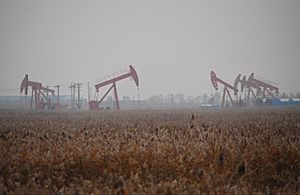Liaohe Plain facts for kids
The Liaohe Plain is a flat area in the southern part of Northeast China. It is known for its many rice fields and is part of the larger Northeast China Plain. This plain is a very important area for industries and farming in Liaoning Province, China.
A huge amount of land here, about 144 million hectares, is used for farming. The area of rice fields in the center of the plain grew a lot between 1988 and 2006. It increased by about 977 square kilometers, which is a very large space!
Contents
Farming and Resources
The Liaohe Plain is a key area for growing maize (corn). It is often called a "golden belt" because so much corn is produced here. This makes it a vital place for providing food for the country.
Climate and Crops
The weather on the Liaohe Plain varies a lot. In January, the average temperature is between 8.6 and -9.8 °C. In July, it's warmer, around 24.4 °C. Farmers usually start watering their crops in early May. This helps the plants grow well.
Main Activities
Besides growing crops, people on the Liaohe Plain do other important things:
- Oil and Gas Exploration: They look for and extract oil and natural gas from underground.
- Aquaculture: This means they farm fish and other water animals.
- Salt Production: They also produce salt, likely from seawater or salt lakes.
Environmental Challenges
Using the land too much has caused some problems for the Liaohe Plain. The ground has started to change shape or sink in some places. This can harm the environment and make it harder to build new projects.
Climate Change Impact
The nearby Liaohe River Basin is one of the areas most affected by climate change in China. However, this area is also very important for growing grain in the Inner Mongolia Autonomous Region of China. Protecting these areas is crucial for both the environment and food supply.


